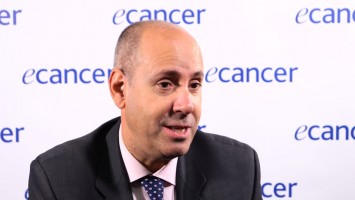Good morning everybody. I am presenting the results of the GEICAM/CIBOMA study conducted by the Spanish group, CIBOMA is a South American group, central South American group, comparing capecitabine to observation in triple negative breast cancer patients with operable disease having received conventional standard adjuvant or neoadjuvant chemotherapy with anthracyclines plus or minus taxanes. This is my disclosure.
I would like to mention that this study was designed in 2004 so fourteen years ago. At that time no information about capecitabine was available for us. As you know, TNBC is sensitive to chemotherapy, to adjuvant chemotherapy but a significant proportion of patients will eventually relapse after conventional anthracycline taxane combinations. So we need new approaches to this population. With that in mind we designed a study in which TNBC patients centrally confirmed in a central lab with stage 1-3 disease and prior standard adjuvant chemotherapy with standard regimens were stratified according to the institution, basal phenotype defined centrally by staining of CK5/6 and/or EGFR – we classified patients as basal-like or non-basal-like, axillary node status and prior chemotherapy – anthracycline alone versus anthracycline plus taxane. They were randomised to capecitabine 1g/m2 b.i.d. for three days every three weeks for eight cycles or observation.
The primary endpoint of the study was disease free survival and secondary endpoints were overall survival, subgroup analysis planned, safety and biomarkers.
In our files, in our registry, the expected three year disease free survival for a similar population of TNBC patients was 64.7% disease free survival at three years and we assumed that capecitabine will increase three years DFS to 73.7%. So the study would need 176 patients for an 80% power to detect a hazard ratio of 0.701.
In that table we have the main patient and tumour characteristics, they were well-balanced between arms in terms of median age, region, status, diagnosis, stage at diagnosis, and nodal status. I would like to remark that 55% of patients who enrolled in the trial were node negative. In terms of type of chemotherapy received by the patients you can see here that most patients received adjuvant chemotherapy alone because at that time neoadjuvant chemotherapy was not very frequent, fourteen years ago remember. Only 18% of patients had neoadjuvant chemotherapy. 22 patients in the capecitabine arm and 19 in observation entered the study in pCR, pathological complete response, after adjuvant chemotherapy but this is only 5% of the overall population. Around two-thirds of the patients received anthracyclines plus taxanes and one-third received ? alone as adjuvant or neoadjuvant therapy.
Here you have the main analysis of the study. After a median follow-up of 7.34 years we have 105 events in the capecitabine arm versus 120 events in the observation arm for a hazard ratio of 0.82 and an adjusted hazard ratio, according to factors of 8.79, p-value is not significant. So the trial is formally negative because it didn’t reach the statistical requirement.
Nothing in overall survival, similar overall survival in both arms and when we look at the subset analysis we found very interesting information regarding the basal status of the patients. We have here the Kaplan-Meier curves of capecitabine versus observation in the left for basal patients – those with staining for EGFR and/or CK5/6 – no difference. On the right you have the non-basal population difference, the hazard ratio for this is 0.53, p-value of 0.020. The interaction test p-value for the comparison is 0.0694. Then you have the overall survival results. On the left, again, no difference in overall survival in the basal population but on the right curve, the right graph, the non-basal population show a big benefit with capecitabine with a hazard ratio of 0.32 for survival and a p-value of 0.007. In that case, the interaction test p-value is very positive, 0.052.
Here you have the time of disease free survival that we observed in the overall population and in the non-basal population, the one achieving the biggest results. Capecitabine is used mainly for distant relapses in the non-basal population and particularly in liver and brain.
So, to conclude, this study formally failed to show a statistically significant increase in disease free survival by adding capecitabine to standard neoadjuvant chemotherapy in early triple negative breast cancer but in a prospective planned subsequent analysis TNBC patients with non-basal phenotype achieved an increase in disease free survival and overall survival with capecitabine. I have not presented any toxicity data because the tolerance of extended capecitabine was exactly as expected, it’s a well-known drug. Thank you very much for your attention.








